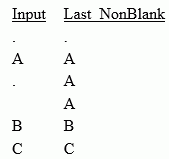Syntax: How to Return the Last Value That is Neither Blank nor Missing
LAST_NONBLANK(field)
where:
- field
-
Is the field name whose last non-blank value is to be retrieved. If the current value is not blank or missing, the current value is returned.
Note: LAST_NONBLANK cannot be used in a compound expression, for example, as part of an IF condition.
Example: Retrieving the Last Non-Blank Value
Consider the following delimited file named input1.csv that has two fields named FIELD_1 and FIELD_2.
, A, , , B, C,
The input1 Master File follows.
FILENAME=INPUT1, SUFFIX=DFIX ,
DATASET=baseapp/input1.csv(LRECL 15 RECFM V, BV_NAMESPACE=OFF, $
SEGMENT=INPUT1, SEGTYPE=S0, $
FIELDNAME=FIELD_1, ALIAS=E01, USAGE=A1V, ACTUAL=A1V,
MISSING=ON, $
FIELDNAME=FIELD_2, ALIAS=E02, USAGE=A1V, ACTUAL=A1V,
MISSING=ON, $
The input1 Access File follows.
SEGNAME=INPUT1, DELIMITER=',', HEADER=NO, PRESERVESPACE=NO, CDN=COMMAS_DOT, CONNECTION=<local>, $
The following request displays the FIELD_1 values and computes the last non-blank value for each FIELD_1 value.
TABLE FILE baseapp/INPUT1 PRINT FIELD_1 AS Input COMPUTE Last_NonBlank/A1 MISSING ON = LAST_NONBLANK(FIELD_1); ON TABLE SET PAGE NOLEAD ON TABLE SET STYLE * GRID=OFF,$ ENDSTYLE END
The output is shown in the following image.
